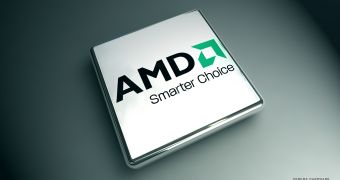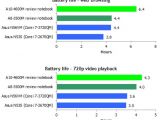Every battery test done on Trinity compared AMD’s reference test systems with retail shipping Ivy Bridge notebooks from different manufacturers.
To stick to the correct principles of benchmarking, when comparing two devices inside a system, the main system should be exactly the same.
Only the performance difference between the compared components should be recorded and considered of use.
When measuring two HDDs, two SSDs or two video cards, the base test system can surely be the same, but what happens when we try to compare two CPUs?
The platforms are different, so the chipsets and mainboards are different.
When analyzing desktop CPUs only the end result is of interest, and power consumption is usually not that important as in the mobile world.
However, since the green/eco conscience has been awaken back in 2006, together with the launch of Intel’s Core 2 Duo CPUs, the power consumption and performance per watt ratios have also been of interest.
And still, there’s a considerable difference between a system that consumes more power and a laptop that stops working because the battery is empty.
Therefore, battery life is very important in the mobile world and it’s logical to be so.
When measuring the battery life of a laptop, the size of the display and the brightness setting are very important factors, as far as power consumption is concerned.
As two laptops don’t have the same displays with the same characteristics, benchmark experts from TechReport.com have decided to compare the battery life while setting the brightness to result in the same measured screen luminosity for all three laptops.
The test compared AMD’s Trinity presentation laptop with ASUS’ N56VM and N53S laptops.
The experts from TechReport.com used a colorimeter to set the luminosity at the same 100 cm/m2 for all three displays.
This resulted in a 40% brightness setting for the Trinity laptop, an even smaller (and advantageous) brightness of 25% for the ASUS N56Vm and a 45% level for the N53S.
Practically, AMD’s laptop has a smaller battery and was set at medium brightness.
Set up like this, AMD’s Trinity yielded a 46% better battery life than ASUS’ N56VM and almost 70% more battery life than the ASUS N53S.
This is quite a significant achievement for AMD’s Trinity, as it clearly shows that its battery life is 46% better than Ivy Bridge’s and a whooping 70% better than Sandy Bridge's.
These settings will most likely occur in the real world anyway as, if the screen is brighter, the user will likely turn the brightness down for less eye strain.
Turning the brightness down should result in better battery life, so practically the 25% brightness level of the ASUS N56VM laptop is an advantage over AMD’s 40% brightness that consumes more power.
It’s great to see that AMD is able to bring some real competition in the mobile field, and we wish they do the same for the desktop world.

 14 DAY TRIAL //
14 DAY TRIAL // 
